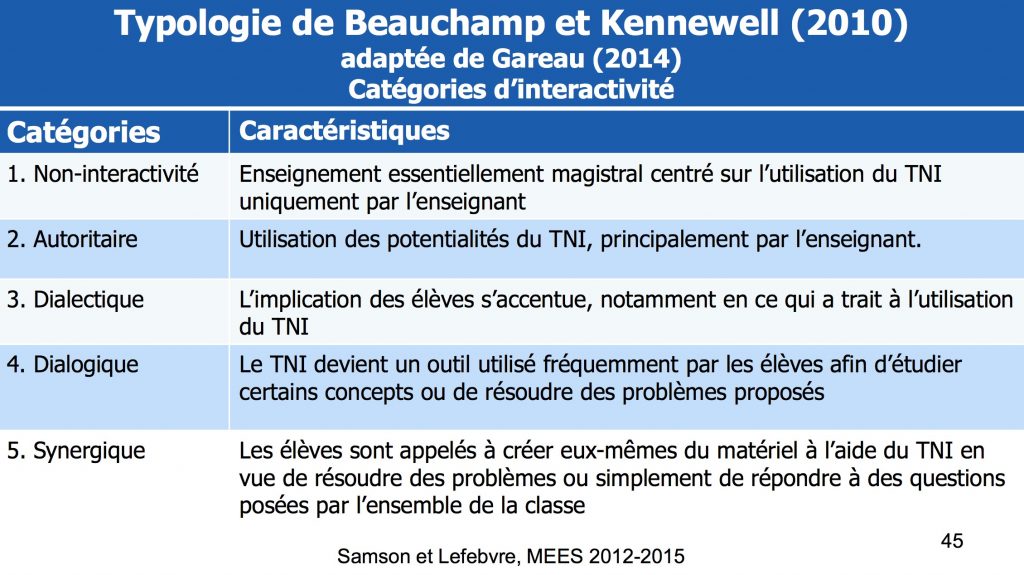Le 4 février dernier, Ghislain Samson et Sonia Lefebvre, professeurs à l’UQTR, ont présenté le bilan de leur recherche portant sur les impacts de l’utilisation du tableau blanc interactif. Quelles sont les pratiques pédagogiques des enseignants du primaire et du secondaire qui l’intègrent à leur pédagogie? C’est ce que leur étude voulait détailler.
Vers 2010, les tableaux numériques interactifs (TNI) faisaient une apparition discrète dans les salles de classe québécoises. Six ans plus tard et mesure financière ministérielle aidant, la plupart des enseignants utilisent un tel périphérique avec ressources didactiques numériques variées. Deux professeurs de l’Université du Québec à Trois-Rivières, Ghislain Samson et Sonia Lefebvre, ont choisi d’étudier l’impact des TNI sur les pratiques pédagogiques des enseignants. Pour ce faire, ils ont pris deux « portraits » d’un échantillon d’enseignants québécois, un premier en 2013-2014, un second en 2014-2015. Ils ont dégagé les usages que ces derniers font de leur TNI en les apparentant à divers modèles théoriques, dont la typologie de Beauchamp et Kennewell (2010).
Cette typologie, qui a aussi servi de base aux travaux menés par Carole Raby et son équipe dans le projet CAP sur le TNI, présente 5 niveaux d’interactivité dans lesquels les enseignants peuvent situer. Ainsi, ces derniers évoluent à travers les différentes catégories d’usage, allant de la non-interactivité, où l’enseignant est en contrôle de la leçon et du TNI pendant une période d’enseignement magistral, jusqu’au niveau synergique où l’usage du tableau est partagé entre l’enseignant et les élèves.
Pour rendre plus concrets les différents usages du TNI, les chercheurs de l’UQTR et leur équipe sont allés plus loin en proposant des portraits types d’enseignants en complément au modèle de Beauchamp et Kennewell. Décrivons-les brièvement et voyons comment se répartissent les pédagogues québécois dans cette typologie.
Notez que les prénoms employés le sont uniquement pour illustrer et visent pas d’individus en particulier!
- Liv, la non-interactive, enseigne à l’aide de son TNI comme s’il s’agissait d’un tableau vert. Son enseignement est plutôt traditionnel. Ses élèves recopient les notes de cours projetées et peuvent procéder au calibrage du tableau. D’après la cueillette de données des professeurs Samson et Lefebvre, 29 % des enseignants se situaient à ce niveau en 2013-2014 comparativement à 23 % en 2014-2015.
- Albert, l’autoritaire, manipule le TNI. Il planifie l’utilisation de certaines ressources et contrôle le rythme de ses leçons. Il peut recourir au TNI pour utiliser les outils mathématiques et faire quelques recherches Web en présence de ses élèves. Ces derniers, quant à eux, sont invités à faire quelques manipulations d’animations. En 2013-2014, 45 % des enseignants utilisaient le TNI de manière « autoritaire » comparativement à 53 % en 2014-2015.
- Monique, la dialectique, utilise le TNI de manière constructive. Elle sélectionne les ressources (liens hypertextes, animations multimédias et vidéos) pour mener les élèves vers la compréhension de contenus. Elle permet à ses élèves d’utiliser les ressources du TNI pour répondre à une question ou résoudre des problèmes. Les chercheurs ont observé que la proportion d’enseignants de type « dialectique » est passée 18 % à 23 % de 2013 à 2015.
- Frédéric, le dialogique, ne se limite pas qu’au logiciel qui accompagne le TNI. Il utilise, lorsque l’activité l’impose, différents logiciels ou animations. Son TNI devient un espace commun où la participation des élèves est encouragée. Ces derniers réfléchissent collectivement, font des relations à l’aide de schémas conceptuels et consignent des données. Ils interagissent entre eux et avec le tableau. Sept pour cent des enseignants étaient de type « dialogique » en 2013-2014 comparativement à 2 % en 2014-2015.
- Enfin, Angélique, la synergique, partage son utilisation du TNI avec ses élèves. Elle l’utilise pour soutenir son enseignement et l’apprentissage dans une perspective de coconstruction. Ses élèves, mini-profs, résolvent et développent des situations problèmes. Toutefois, un seul enseignant de l’échantillon se situait à ce niveau en 2013-2014. Aucun en 2014-2015. « Ce type d’usage non répandu pourrait s’expliquer par le peu d’enseignants possédant une très grande expérience d’enseignement avec le TNI. Intégrer pleinement à sa pratique un outil technologique comme le TNI demande du temps.», selon Sonia Lefebvre.
Et vous, où vous situez-vous?
Pour en savoir davantage





 Recevez l'Info #DevProf et l'Hebdo pour ne rien manquer des nouveautés de l'École branchée!
Recevez l'Info #DevProf et l'Hebdo pour ne rien manquer des nouveautés de l'École branchée!




